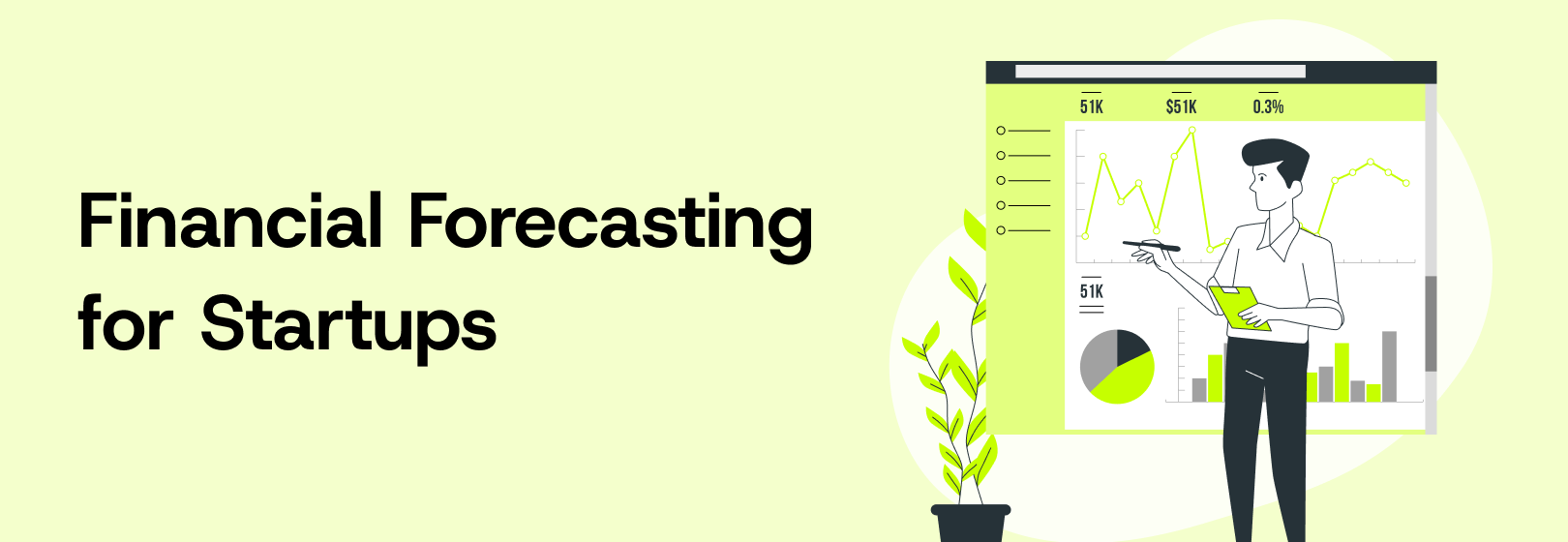Starting a new business brings dreams, ambitious goals, and continuously determined effort as a startup founder. Initiating ideas into tangible reality requires far more than visionary thinking because you must establish funding plans with numerical backing to attract investors and effective scale-up strategies. The implementation of financial forecasting provides all necessary benefits.
The financial forecast you create needs to perform functions beyond number calculations since it enables you to both understand your startup and forecast upcoming cash requirements while remaining prepared for future industry obstacles. A strong forecast stands as one of the essential instruments you need to manage your startup operations.
In this article, you’ll learn everything you need to know to build a financial forecast for your startup—step by step, without jargon, and with examples to clarify it.
What Is Financial Forecasting?
Startups use financial forecasting to identify expected money-related outcomes that will appear in future periods. Such projections cover revenue expectations, expense needs, cash flow development, and organization profitability. Your enterprise depends heavily on forecasts because they appear across your pitch decks and business plans and serve for internal decision-making.
A budget functions as a stable spending plan, but financial forecasts operate as a strategic, flexible version of budgetary presentations. Your forecast predictions demonstrate the actual potential outcomes from analyzing present information, projected data and market trends.
The purpose of a financial forecast isn’t to predict the future with 100% accuracy. Instead, it’s meant to give you a working model of your future, so you can test different scenarios and stay one step ahead.
Step-by-Step Guide to Financial Forecasting for Startups
Let’s break down the forecasting process into clear, manageable steps so you can start building your own forecast confidently.
Step 1: Define the Time Frame
In the first step identify the length of future time that needs forecasting. A 12-month forecast serves startups well but building forecasts extending three to five years will help startups that seek investment capital.
Artificial business planning requires short-term forecasting tools to make operational selections about staffing for another quarter. Strategic long-term prediction helps you manage growth targets and develop strategies for business expansion.
Most startups prepare monthly revenue predictions during their inaugural year yet afterward they use quarterly or annual projections.
Step 2: Estimate Revenue
The process of revenue prediction stands as the most rewarding yet toughest stage in this operation. Your task involves estimating your startup’s financial outcomes.
Your first task should be to define how you will generate revenue. To achieve success SaaS startups can expect revenue from monthly subscription payments. A product sales marketplace represents the main source of revenue for eCommerce brands. Estimate both the number of units and subscriptions you predict to sell together with their predicted prices.
Data provided by market research and pre-launch signups as well as website traffic and similar business conversion rates can guide your decisions. You can begin through initial assumptions yet you must prepare supporting evidence from logic models.
The approach for creating revenue forecasts can be either bottom-up or top-down Many investors prefer the bottom-up approach because it’s more grounded in reality.
Read More: Comprehensive Guide to Financial Modeling for Small Businesses
Step 3: Estimate COGS
After establishing revenue levels determine the actual production expenses for your product or service delivery. That’s your COGS.
Physical product businesses must include finances related to raw materials, manufacturing costs, packaging expenses and delivery shipping expenses. A SaaS business typically needs cloud hosting support staff and software licenses in addition to its revenue projection.
After you deduct COGS amounts from your revenue you will reach gross profit numbers. After subtracting basic product costs your profit amount becomes visible to you. High gross profit margin levels typically stand out to potential investors as beneficial signals.
Step 4: Forecast Operating Expenses
Now factor in all the other costs of running your startup. This includes team salaries, rent, utilities, tools, advertising, legal fees, and anything else not directly tied to production.
Many of these expenses are fixed or semi-fixed, meaning they stay the same regardless of how much you sell. Others—like marketing or commission—may scale with sales.
List out each major category and forecast what you’ll spend each month. Be honest here—don’t underestimate costs to make the forecast look good. It’s better to plan for reality.
Also, don’t forget one-time costs like branding, product development, or equipment purchases. These can be substantial, especially in the early months.
Read More: Key Benefits of Cash Flow Forecasting for Your Company
Step 5: Build Your Profit & Loss Forecast
You can build your profit and loss statement with revenue, COGS, and operating expenses in place. This shows your projected net income—what’s left after all expenses are subtracted from revenue.
Startups often show losses in the early months or even years. That’s okay, as long as there’s a clear path to profitability. What matters is that you understand when you might break even and what it takes to get there.
Your P&L forecast helps you identify whether your business model makes financial sense and how much cash you’ll need to survive until revenue ramps up.
Step 6: Build Your Cash Flow Forecast
Profit doesn’t always equal cash in hand. You may invoice a customer in January but not get paid until March. You might buy inventory months before you sell it. These timing differences can cause cash flow problems even in seemingly profitable businesses.
A cash flow forecast shows when money actually enters and leaves your account. This includes revenue, COGS, and operating expenses—but also things like tax payments, loan repayments, and funding injections.
Start with your current cash balance. Add cash inflows and subtract monthly outflows to track your projected cash position. If it dips too low, that’s a red flag—and a signal that you may need to raise capital, cut costs, or delay spending.
This forecast is significant for startups with long sales cycles or large upfront costs.
Step 7: Model Different Scenarios
No forecast is complete without considering what could go wrong—or better yet, what could go really right.
Build different versions of your forecast: a base case (most likely scenario), a worst case (if growth is slower or costs are higher), and a best case (if things take off faster than expected).
Scenario modeling helps you prepare for uncertainty and make contingency plans. It also shows investors that you’ve thought things through and aren’t blindly optimistic.
You don’t need to change every line item—just adjust a few key variables like sales growth, pricing, or marketing spend to see the impact on your bottom line.
How Investors View Your Forecast?
Investors know that forecasts aren’t crystal balls. They’re not expecting perfection—but they are expecting insight. They want to see that you understand your business model, your market, and your numbers.
A forecast that’s wildly unrealistic can do more harm than good. So be transparent about your assumptions, and if you’re unsure about something, say so. Many investors will dig into your assumptions during due diligence, so be prepared to explain how you arrived at your numbers.
Focus on telling a story with your forecast—one that aligns with your vision, shows how you plan to grow, and proves you’ve thought through the details.
Conclusion
Financial forecasting may seem like a daunting task, especially when you’re deep in the weeds of building your startup. But it’s one of the most valuable things you can do for your business. It turns your idea into a roadmap, your passion into a plan, and your strategy into something measurable.
By following the steps in this guide, you’ll be able to build a financial forecast that not only makes sense but gives you confidence and control. Whether you’re pitching to investors, planning your cash runway, or simply trying to grow responsibly, forecasting is the tool that turns dreams into doable.
So take the time to do it right. Start small, iterate often, and don’t be afraid to revise your numbers as you learn. After all, the best startup founders aren’t just dreamers—they’re planners too.

![How to Startup Create Startup Financial Projections [+Template]](https://www.modelreef.io/wp-content/uploads/2025/04/Financial-Projections-1-300x195.png)

![What is a Normal Balance in Accounting? Step-by-Step Guide [+Free Template]](https://www.modelreef.io/wp-content/uploads/2025/04/Normal-Balance-in-Accounting-1-300x195.png)